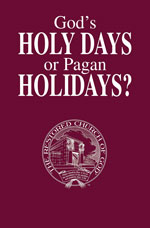The first rays of sunlight bring into view the metropolis of ancient Pergamos, with a skyline dominated by temples, amphitheaters and auditoriums dedicated to a myriad of false gods. A legendary acropolis complex glistens on its hilltop setting.
Daylight soon illuminates attention-grabbing idolatrous shrines, such as Zeusâ 40-foot-tall altarâone of the seven wonders of the ancient world. Other buildings honor Roman emperors.
Amid this cacophony of false religion, a few faithful Christians dwell in the city.
Anyone walking the streets during the prime years of this city would be immediately confronted by a world awash in decadence. Pergamos was home to a renowned school of sculpture, which meant elaborate idols were everywhereâusually depicting gods in the nude.
In this setting of rank idolatry, it would have been difficult for any true Christian to remain faithful.
As Godâs Church grew across Asia Minor, so did a hybrid religion attempting to blend the Bible with the Babylonian Mystery Religion. Both groups called themselves Christians, and both suffered persecution. By AD 300, the persecution had reached fever pitch. Many Roman emperors had made it a mission to hunt down and kill every Christian they could find.
When Roman Emperor Constantine declared religious freedom for the realm, it may have at first seemed like good news. But this only lasted a short while. In 321, he commanded no work be done on Sunday. Then, in 325, he issued an edict that would change all true Christiansâ livesâkeeping the Sabbath was now forbidden.
Constantine declared: âWe have directed, accordingly, that you be deprived of all the houses in which you are accustomed to hold your assemblies, and our care in this respect extends so far as to forbid the holding of your superstitious and senseless meetings, not in public merely, but in any private house or place whatsoever.
âLet those of you, therefore, who are desirous of embracing the true and pure religion, take the far better course of entering the Catholic ChurchâŚâ (The Life of Blessed Emperor Constantine).
Read between the lines of this edict and realize it is aimed almost solely against Sabbath-keepers. Constantine meant that true Christians should âbe deprived of all the houses in which you are accustomed to hold your [Sabbath] assembliesââbe forbidden to hold âsuperstitious and senseless [Sabbath] meetingsââand give up observing Saturday to âtake the far better course of entering the Catholic Church,â which required Sunday-keeping!
With heated persecution against Godâs Church increasing, true Christians fled to Armenia. This flight began the third Church era, Pergamos. Much of the trials, persecution and even internal problems in this chapter of Church history contain vital lessons for today.
Satanâs Seat
In the book of Revelation, Christ uses seven cities in an ancient mail route in Asia Minor as types of the eras of His Church. The message to the third era, which occurred from AD 325 to AD 1000 begins with a striking remark: âAnd to the angel of the church in Pergamos write; These things says He which has the sharp sword with two edges; I know your works, and where you dwell, even where Satanâs seat isâ (Rev. 2:13).
The ancient city of Pergamos, with all its temples and idols, was certainly a type of âSatanâs seat.â How much more would this apply to the third Church era, when brethren lived under a government through which Satan influenced both the laws of the land and its religion?
Brethren of this era had to remain faithful in all points of Godâs Lawâeven in the face of martyrdom. Christ confirmed this by commending Pergamos: ââŚand you hold fast My name, and have not denied My faith, even in those days wherein Antipas was My faithful martyr, who was slain among youâŚâ (Rev. 2:13).
When the Church fled persecution under the Roman Empire, they settled in the wilderness near Constantinopleâthe capital of the empire during that time, and another type of âSatanâs seat.â
Having a government that championed the universal church took its toll on true Christians. Even after the time of Constantine, the Roman church fiercely persecuted them. This led brethren to look for ways to âfit in,â causing a number of problems to enter the Church.
Christ rebuked this era for its compromising attitude: âBut I have a few things against you, because you have there them that hold the doctrine of Balaam, who taughtâŚthe children of Israel, to eat things sacrificed unto idols, and to commit fornicationâ (Rev. 2:14).
One definition of the doctrine of Balaam is found in Encyclopaedia Britannica: âThey [Pergamos-era Christians] permitted external conformity with the dominant Church, and held that Christ would forgive it.â
In time, the act of practicing what they knew to be error soon became ingrained. This compromise caused a searing of their consciences and led to their children following Catholic practices, including attending mass.
Christ warned this era: âRepent; or else I will come unto you quickly, and will fight against them with the sword of My mouthâ (Rev. 2:16).
âWhich Thing I Hateâ
The doctrine of Balaam leads to another problemâa second weakness of the Pergamos era. Notice: âSo have you also them that hold the doctrine of the Nicolaitans, which thing I hateâ (Rev. 2:15).
The doctrine of the Nicolaitans was that of unrestrained indulgence. Once brethren broke down their walls of resistance and started following pagan practices, their mental defenses eventually vanished as they returned fully to the world. Thus, the doctrine of the Nicolaitans usually completed the job that the doctrine of Balaam had begunâwholesale abandonment of Godâs Law.
This doctrine permits individuals to engage in sin. This sort of thinking can be seen in statements such as, âWe are only humanâââOther people do the same thingâââTheir church allows them to do this.â
These ideas can still arise today!
This mindset allowed people to become âfamiliarâ with sin to the point it became a lifestyle. Many who once were in the Church of God went back to the world by compromising standardsâthey excused themselves, thinking, âWe must not be so conspicuous.â
This thinking is deadly!
The doctrines of Balaam and the Nicolaitans worked in conjunction during the Pergamos era, causing many of Godâs people to stray from sound doctrine and godly behavior. Some brethren allowed themselves to be overcome.
Modern Lessons
In the 21st century, the allure of wrong behavior is everywhereâbillboards, television, Internet social networks, movies. It never disappears. It never relents!
Yet we must fight this sinful enticement by resisting. As Godâs people, we fight covetousnessâa fight that takes place in the mind. Without righteous priorities and goals, covetousness will overrun us and crush our attempts to flee its influence.
Ask: What takes your time? Who are your friends? Do you associate with groups that have goals that are incompatible with Godâs kingdom? Have you been enticed to go back to the âpleasures of sinâ mentioned in Hebrews 11:25? Be honest with how you answer, and work to root out any problem areas.
As in ancient Pergamos, modern cities are replete with idolatry: jutting steeples from false churches, stadiums and auditoriums dedicated to false âgodsâ of entertainment and sports, roads lined with tempting billboards that promote lust, covetousness and sinful behavior. False doctrines and religious confusion prevailâeven in supposed âchurches of Godâ (the splinters).
In this permissive world, consider the lessons of the Pergamos era:
- We must resist the modern-day temptations to give in to the doctrine of Balaam, which places temptation before people, causing them to sin. Instead, âSubmit yourselves therefore to God. Resist the devil, and he will flee from youâ (Jms. 4:7). Resist, avoid and flee every evil influence!
- We must beware of any who water down doctrine and self-appointed teachers who give permission to live deviant lifestyles and disobey Godâs commands. This is the doctrine of the Nicolaitans!
- We must hate sin. Learn to abhor sin as God does, and cling to His Law! âThrough Your precepts I get understanding: therefore I hate every false wayâ (Psa. 119:104).
- We must find any hint of negative qualities of the era of Pergamos in our lives, then repent and overcome.
Some of that time did heed Christâs warning. Christians today must do the same, and qualify for the same reward mentioned in Revelation 2:17: âTo him that overcomes will I give to eat of the hidden manna [spiritual food], and will give him a white stone, and in the stone a new name written, which no man knows saving he that receives it.â
Those who overcome and avoid the doctrines of Balaam and the Nicolaitansâand hate every false wayâwill be named among those in the God Family and rule in His kingdom!
(Read Where Is the True Church? â and Its Incredible History! to learn more about Church eras.)

















